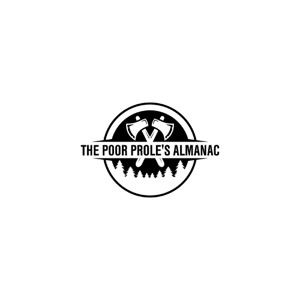Corn: From Ubiquitous Crop to Controversial Commodity
The Poor Prole’s Almanac - Podcast tekijän mukaan The Poor Prole’s Alamanac, Bleav

Kategoriat:
This episode of "The Poor Proles Almanac," celebrating its 100th episode, focuses on the history of corn in America, specifically its transformation from a food primarily consumed by poor people to a ubiquitous ingredient in modern diets. The hosts, Elliott and Andy, use humor and historical analysis to explore the complex factors that led to corn's dominance in the American food system, including technological advancements, government policies, and the crop's unique biological properties. Early History and the Rise of Corn Whiskey: Prior to the 1800s, corn was a staple food for poor communities and prisoners in the United States. With the advent of the Industrial Revolution, three key technologies—the iron plow, railroads, and canneries—revolutionized corn production and distribution. The iron plow allowed farmers to cultivate larger areas, while railroads enabled efficient transportation of corn across the country. Canneries provided a means to preserve and store corn, further increasing its value. This confluence of technologies led to a surge in corn production and a boom in the corn whiskey industry. Farmers, seeking to maximize profits and address the challenges of storing and transporting diverse corn varieties, turned to whiskey production. By the 1820s, the average American consumed five gallons of hard liquor annually, a testament to the popularity and profitability of corn whiskey. Standardization, Hybrid Strains, and the Haber Process: As the corn industry grew, issues arose regarding the lack of standardization in corn varieties. The diversity in size, color, and kernel characteristics made packaging, trading, and selling corn difficult. To address this, trade boards and rail hubs encouraged farmers to breed a standard crop. James Reid's "Yellow Dent Corn," which won the blue ribbon at the 1893 World's Fair, emerged as the dominant variety. This standardized corn, with its hard kernels, was shelf-stable, easily transportable, and ideal for processing. However, by the late 1800s, corn yields began to stagnate, prompting government intervention. Policymakers, concerned about food security, implemented initiatives such as irrigation projects, dam construction, and further investment in railroads. These efforts aimed to increase food production and ensure efficient transportation to urban centers. In the early 20th century, scientists developed hybrid corn strains that significantly boosted yields. These hybrids, coupled with the introduction of industrial fertilizers, led to an unprecedented increase in corn production. The Haber process, developed in 1909 by German chemist Fritz Haber, played a crucial role in this growth. The process enabled the synthesis of plant-available nitrates from the air, providing a readily available source of nitrogen fertilizer. However, the process was energy-intensive, consuming two percent of the global energy supply to produce nitrogen for farming. This dependence on fossil fuels for fertilizer production raised concerns about the environmental sustainability of corn production. Government Intervention, Subsidies, and the Dust Bowl: The rapid increase in corn production led to market saturation and plummeting prices, causing economic hardship for farmers. The Great Depression and the subsequent Dust Bowl further exacerbated the crisis. The government responded with subsidies, price supports, and land diversion programs to stabilize the agricultural sector. The Dust Bowl, a period of severe drought and dust storms in the 1930s, had a profound impact on agricultural policies. It instilled a fear of food shortages in policymakers, leading to a focus on maximizing corn production. Government programs encouraged farmers to increase yields and provided incentives for surplus production, even as the oversupply contributed to lower prices. World War II and the Rise of Corn-Based Products: World War II further intensified corn production. The government incentivized farmers to plant "war crops," primarily corn, wheat, and oats, to support the war effort. Additionally, the wartime production of ammonium nitrate for munitions led to a surplus of fertilizer, which further boosted corn yields. Following the war, the government continued to subsidize corn production and sought ways to utilize the massive surplus. This led to the development and proliferation of corn-based products, including high fructose corn syrup, animal feed, and ethanol. High fructose corn syrup, cheaper than sugarcane due to corn subsidies, became a ubiquitous ingredient in processed foods. Corn also became the primary feed for livestock, as its low cost and abundance made it an economically viable option. Ethanol production, while not the most efficient use of corn, emerged as another avenue to utilize the surplus. The Environmental and Social Impacts of Corn Dominance: The episode concludes by discussing the environmental and social consequences of corn's dominance in the American food system. The hosts acknowledge that corn has played a significant role in ensuring food security and has adapted to a wide range of climates. However, they also critique the reliance on industrial fertilizers, the environmental damage caused by monoculture farming, and the negative health impacts associated with the overconsumption of corn-based products. The hosts express concern that the current system of corn production is unsustainable and perpetuates a cycle of overproduction, low prices, and government intervention. They advocate for a more balanced approach to agriculture, one that prioritizes diversity, sustainability, and the well-being of both farmers and consumers. The episode offers a thought-provoking and humorous exploration of the complex history of corn in America. It sheds light on how a once humble crop became a powerful force shaping the nation's food system, economy, and environment. For sources, transcripts, and to read more about this subject, visit: www.agroecologies.org To support this podcast, join our patreon for early, commercial-free episode access at https://www.patreon.com/poorprolesalmanac For PPA Restoration Content, visit: www.restorationagroecology.com For PPA Merch, visit: www.poorproles.com For PPA Native Plants, visit: www.nativenurseries.org To hear Tomorrow, Today, our sister podcast, visit: www.tomorrowtodaypodcast.org/

